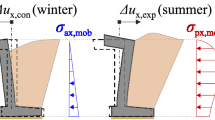Abstract
Most building elements are a composite of different material layers; however the majority of the works presented in literature were developed for multi-layered elements with perfect contact interface, without resistance. Experimental results presented in literature showed that a considerable hydraulic resistance could be created by the imperfect contact between two porous building materials. Moisture transport in multi-layered building elements can deviate from the moisture transport found for the combination of the single material elements, so the assumption of perfect hydraulic contact could lead to significant errors in predicting the moisture transport. This work presents an experimental campaign and a critical analysis of water absorption in samples of two different building materials (clay brick and autoclaved aerated concrete) with and without joints at different positions (heights) and different contact configurations (natural contact and air space between layers). The results show that when the moisture reaches the interface there is a slowing of the wetting process due to the interfaces hygric resistance. The interfaces hygric resistance, in the AAC samples, is only observed for the joint located from a distance of 2 cm of the wetting plane. The penetration coefficient of the two building materials analysed is very different. Finally, the evolution of the distribution of liquid in the porous medium was analysed in terms of the Boltzmann transform method and anomalous diffusion equation.








Similar content being viewed by others
Abbreviations
- A :
-
Contact area (m2)
- A W :
-
Water absorption coefficient (kg/m2s0.5)
- B :
-
Water penetration coefficient (m/s0.5)
- D W :
-
Moisture diffusion coefficient (m2/s)
- h :
-
Penetration depth (m)
- m t :
-
Weight of the specimen after time t (kg)
- m 0 :
-
Initial mass of the specimen (kg)
- M t :
-
Total amount in time t (kg/m2)
- n :
-
Real number (-)
- P c1 :
-
Suction pressure of material 1 (Pa)
- P c2 :
-
Suction pressure of material 2 (Pa)
- q :
-
Moisture flow across the interface (kg/m2s)
- Q max :
-
Maximum transport flow (kg/m2s)
- R :
-
Hygric resistance (m/s)
- t :
-
Time (s)
- x :
-
Axial-coordinate (m)
- w :
-
Volumetric moisture concentration (kg/m3)
- w 0 :
-
Initial volumetric moisture concentration (kg/m3)
- w ∞ :
-
Equilibrium volumetric moisture concentration (kg/m3)
- α :
-
Variable given by \( \alpha = 1/(n + 1) \) (−)
- η :
-
Boltzmann variable (m/s0.5)
- η* :
-
Similarity variable, \( \eta * = x/t^{\alpha } \) (m/sα)
- ρ :
-
Density (kg/m3)
References
Brocken HJP (1998) Moisture transport in brick masonry: the grey area between bricks. PhD Thesis, Eindhoven University
Delgado JMPQ, Ramos NMM, Barreira E, Freitas VP (2010) A critical review of hygrothermal models used in porous building materials. J Porous Media 13:221–234
Qiu X (2003) Moisture transport across interfaces between building materials. PhD Thesis, Concordia University
Qiu X, Haghighat F, Kumaran MK (2003) Moisture transport across interfaces between autoclaved aerated concrete and mortar. J Build Phys 26:213–236
Derluyn H, Janssen H, Carmeliet J (2011) Influence of the nature of interfaces on the capillary transport in layered materials. Constr Build Mater 25:3685–3693
Janssen H, Derluyn H, Carmeliet J (2012) Moisture transfer through mortar joints: a sharp-front analysis. Cem Concr Res 42:1105–1112
Freitas VP (1992) Moisture transfer in building walls—interface phenomenon analysis. PhD Thesis, FEUP (in Portuguese)
Küntz M, Lavallée P (2001) Experimental evidence and theoretical analysis of anomalous diffusion during water infiltration in porous building materials. J Phys D Appl Phys 34:2547–2554
Taylor SC, Hoff WD, Wilson MA, Green KM (1999) Anomalous water transport properties of Portland and blended cement-based materials. J Mater Sci Lett 18:1925–1927
Hall C (2007) Anomalous diffusion in unsaturated flow: fact or fiction? Cem Concr Res 37:378–385
Lockington DA, Parlange JY (2003) Anomalous water absorption in porous materials. J Phys D Appl Phys 36:760–767
El Abd AG, Milczarek JJ (2004) Neutron radiography study of water absorption in porous building materials: anomalous diffusion analysis. J Phys D Appl Phys 37:2305–2313
Küntz M, Lavallée P (2004) Anomalous diffusion is the rule in concentration-dependent diffusion processes. J Phys D Appl Phys 37:L5–L8
Crank J (1975) The mathematics of diffusion. Oxford Science, New York
Philip JR (1969) Theory of infiltration. Adv Hydrosci 5:215–296
CEN/TC 89/WG10 N70 (1994) Thermal performance of buildings and building components—determination of water absorption coefficient
Hall C, Yau MHR (1987) Water movement in porous building materials—IX. The water absorption and sorptivity of concretes. Build Environ 22:77–82
Hall C, Hoff WD (2002) Water transport in brick, stone and concrete. Spon, London and New York
Kreijger PC (1984) The skin of concrete: composition and properties. Matér Constr 17:275–283
Dullien FAL (1979) Porous media: fluid transport and pore structure. New York Academic, New York
Acknowledgments
The research work presented herein was supported by FEDER funds through the Operational Programme for Competitiveness Factors—COMPETE and by national funds through the FCT—Portuguese Foundation for Science and Technology, under research project. J.M.P.Q. Delgado would like to thank FCT for financial support through the Grant SFRH/BPD/84377/2012.
Author information
Authors and Affiliations
Corresponding author
Rights and permissions
About this article
Cite this article
Delgado, J.M.P.Q., de Freitas, V.P. & Guimarães, A.S. Water movement in building walls: interfaces influence on the moisture flux. Heat Mass Transfer 52, 2415–2422 (2016). https://doi.org/10.1007/s00231-016-1755-z
Received:
Accepted:
Published:
Issue Date:
DOI: https://doi.org/10.1007/s00231-016-1755-z




